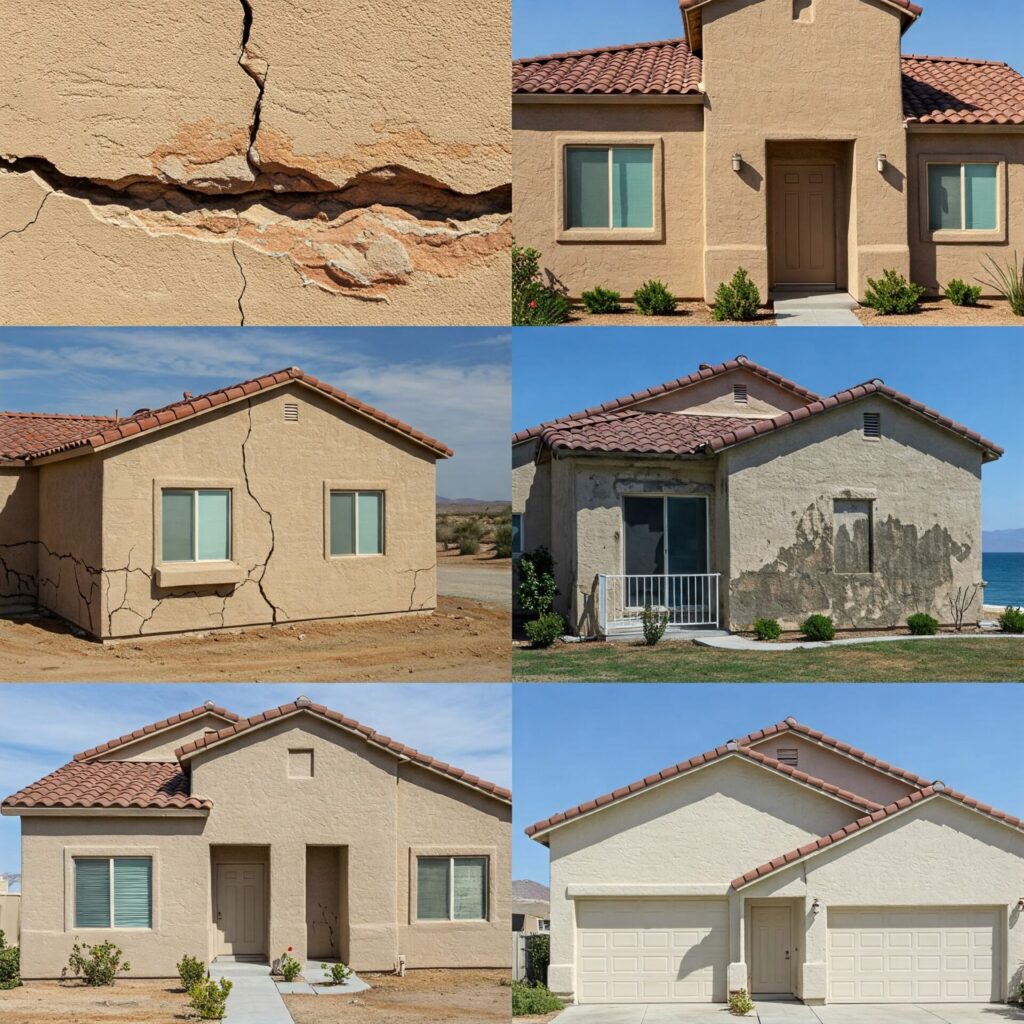When it comes to home exteriors, stucco remains a popular choice for its clean look, durability, and energy efficiency. But just like any material exposed to the elements, stucco doesn’t last forever. If you’re considering stucco for your home or if you already have it, it’s important to understand how long it can realistically hold up, what factors affect its lifespan, and how to maintain it for decades of beauty and protection.
Table of Contents
ToggleYou might like: How to Spot a Load-Bearing Wall: Expert Guide for Homeowners

Factors That Influence Stucco’s Lifespan
Several factors can shorten or extend how long your stucco exterior lasts:
Quality of Installation: Poor application is the number one reason stucco fails early. Proper layering, curing, and moisture barriers are critical.
Climate: Stucco performs best in dry climates. In areas with heavy rainfall, freezing temperatures, or high humidity, it can be more prone to cracking or moisture damage.
Maintenance: Small cracks or damage need quick attention. Allowing moisture to seep behind the stucco can lead to costly structural issues.
Material Type: Traditional three-coat stucco is more durable than some synthetic alternatives, although newer synthetic options (like EIFS) have their own benefits when correctly installed.
Foundation Stability: Homes with shifting foundations or significant settling can cause stress on the stucco, leading to cracking.
Signs Your Stucco Needs Attention
Even a sturdy stucco exterior can show signs of wear over time. Look out for:
Hairline Cracks: These are common and often harmless but should still be monitored.
Bulging or Warping: This may indicate trapped moisture behind the stucco.
Staining or Discoloration: Often a warning sign of moisture penetration.
Chunks Falling Off: If pieces are breaking away, you likely have deeper underlying problems.
Early intervention can save you thousands in repairs, so don’t ignore small issues.
How to Extend the Life of Your Stucco
To keep your stucco looking and performing its best, follow these simple guidelines:
Inspect Regularly: Walk around your home every few months to spot cracks or damage.
Seal Cracks Quickly: Use a flexible, paintable caulk designed for masonry to seal minor cracks.
Clean Periodically: Dirt and algae can trap moisture against the stucco. Gently clean the surface with a hose or low-pressure washer as needed.
Repaint When Necessary: A high-quality elastomeric paint can provide an additional layer of protection against water.
Address Drainage Issues: Ensure gutters and downspouts move water away from your walls to prevent pooling.
Maintaining and Prolonging the Lifespan of Stucco
Proper maintenance is the key to maximizing the lifespan of your stucco exterior. With regular care, you can keep your stucco looking beautiful and structurally sound for decades. Here’s how:
1. Regular Inspections
Walk around your home at least twice a year to look for hairline cracks, stains, or areas where the stucco may be pulling away from the wall. Early detection of problems can prevent more extensive damage.
2. Prompt Repairs
Even small cracks can allow moisture to penetrate the surface and cause larger issues over time. Use high-quality, flexible sealants to quickly patch minor cracks and prevent water intrusion.
3. Proper Cleaning
Dirt, mildew, and algae buildup can deteriorate the stucco finish over time. Clean your exterior annually using a low-pressure wash and mild detergent. Avoid high-pressure washing, as it can damage the surface.
4. Repainting and Sealing
Applying a breathable, elastomeric paint or sealer every 5–7 years helps protect the stucco from moisture and UV damage. This added layer acts as a shield against harsh weather conditions.
5. Manage Drainage and Landscaping
Ensure gutters, downspouts, and landscaping direct water away from stucco walls. Water pooling near the foundation can lead to moisture problems and cracking.
When to Consider Stucco Replacement
While stucco is known for its durability, there comes a point when repairs are no longer enough to maintain its integrity. If you notice widespread cracking, large chunks falling off, or significant bulging and staining, it may be time to consider a full stucco replacement. These issues often indicate deeper problems, such as trapped moisture or structural damage behind the surface, which simple patchwork cannot fix.
Persistent water stains, soft spots, or a musty odor inside your home can also signal hidden moisture intrusion — a serious concern that can lead to mold growth and compromised structural integrity if left unaddressed. Additionally, if your stucco was improperly installed or has exceeded its expected lifespan, replacing it can prevent more costly damage in the future.
Choosing to replace your stucco isn’t just about repairing damage; it’s an opportunity to upgrade your home’s insulation, enhance curb appeal, and even switch to a more modern or maintenance-friendly finish if desired.
Hiring Professional Stucco Contractors
While stucco is a durable and low-maintenance material, ensuring it’s properly installed and maintained requires expert skills. Here’s why hiring a professional stucco contractor is essential for the long-term health of your home:
1. Proper Installation
Stucco requires careful installation, with multiple layers of materials applied to the exterior of your home. A skilled contractor knows how to properly prepare the surface, apply the stucco, and ensure that moisture barriers are installed to prevent water damage. Mistakes during installation can lead to costly repairs down the road.
2. Expertise in Material Selection
There are several types of stucco, including traditional three-coat, synthetic, and EIFS (Exterior Insulation and Finish System). A professional contractor will assess your home’s needs and recommend the best material for your climate and aesthetic preferences. They’ll also know which products are best for durability and weather resistance.
3. Experience with Local Codes
Stucco installation and repairs often involve specific local building codes and regulations. Professional stucco contractors are familiar with these standards and will ensure your project meets all legal requirements, avoiding potential fines or future issues.
4. Long-Term Value
Hiring an experienced contractor ensures that your stucco is not only applied correctly but also properly maintained. A job done right will last much longer, saving you money on repairs and replacements in the future.
5. Warranty and Insurance
Reputable stucco contractors typically offer warranties on their work, giving you peace of mind that if something goes wrong, they’ll be there to address it. Additionally, they carry insurance to protect you from potential damages or accidents during the job.

Alternative Options to Stucco
While stucco is a fantastic choice for many homes, it’s not the only option when it comes to durable and attractive exteriors. Depending on your climate, budget, and design goals, you might want to consider these alternatives:
1. Fiber Cement Siding
Fiber cement siding, like James Hardie products, offers the look of wood or masonry with outstanding durability. It’s resistant to fire, pests, rot, and extreme weather, making it a popular choice in a variety of climates. Plus, it comes in many colors and styles for a customized appearance.
2. Brick Veneer
Brick is a classic, low-maintenance material that offers incredible longevity — often over 100 years. While real brick construction is expensive and heavy, brick veneer offers the same timeless look at a fraction of the cost and weight.
3. Vinyl Siding
Vinyl siding is one of the most budget-friendly options available. It’s lightweight, easy to install, and comes in a wide variety of colors and textures. While it may not offer the same luxurious look as stucco, modern vinyl siding has improved significantly in appearance and durability.
4. Wood Siding
For a warm, natural look, nothing beats real wood. Options like cedar or redwood are popular for their natural resistance to decay and insects. However, wood requires regular maintenance (painting, staining, sealing) to protect it from weather damage.
5. Stone Veneer
Stone veneer provides a high-end, rustic appearance without the massive weight and cost of full stone walls. It’s made from natural or manufactured stone and can dramatically enhance a home’s curb appeal.
6. Engineered Wood Siding
This material is made from composite wood products and offers the appearance of real wood with improved resistance to moisture, pests, and fire. It’s a great middle ground between affordability, performance, and aesthetic appeal.
Choosing the Right Exterior for Your Home
Every material comes with its pros and cons. Your best option will depend on factors like your local climate, aesthetic preferences, maintenance willingness, and budget. Consulting with an experienced contractor can help you weigh your options and choose the best exterior material to match your lifestyle and long-term goals.
Use Cases for Stucco: Issues and Solutions
Stucco is often chosen because it solves very specific challenges in home and building design. Here’s how stucco addresses common issues across different types of projects:
1. Traditional Residential Homes
Issue: Homes in hot, dry climates need a material that withstands high temperatures and helps regulate indoor cooling costs.
Solution: Stucco’s natural insulating properties and heat resistance make it ideal for hot, arid regions. It reflects sunlight and maintains indoor comfort while reducing energy bills.
2. Modern and Contemporary Architecture
Issue: Sleek, minimalist home designs require a smooth, clean exterior material that won’t detract from the aesthetic.
Solution: Stucco can be finished with a smooth application that enhances modern architecture, offering a seamless, high-end appearance with minimal maintenance.
3. Mediterranean and Spanish-Style Homes
Issue: Architectural styles that aim for old-world charm need a material that can be textured, colored, and shaped easily.
Solution: Stucco’s versatility allows for custom textures and earth-toned finishes that perfectly match Mediterranean, Spanish Colonial, and Mission-style homes, achieving an authentic, timeless look.
4. Commercial Buildings
Issue: Businesses need exterior materials that are durable, cost-effective, and visually appealing to attract customers and withstand wear and tear.
Solution: Stucco provides long-lasting, low-maintenance protection with a polished, professional finish that holds up against weather and daily environmental stresses.
5. Outdoor Features
Issue: Outdoor structures like kitchens, garden walls, and pool areas require durable, moisture-resistant materials that blend with home exteriors.
Solution: Stucco’s water-resistant and durable nature makes it an excellent choice for outdoor elements, offering continuity in design and reliable protection against the elements.
6. Multi-Family Housing
Issue: Apartments, condos, and townhouses require affordable, large-scale exterior solutions that also help reduce noise between units.
Solution: Stucco is cost-effective for wide applications and provides excellent sound insulation, enhancing privacy and living quality for residents.
Stucco: A Practical Solution for Every Need
Whether you’re facing challenges with climate, design expectations, or budget, stucco consistently offers solutions that make it a go-to choice for homeowners, builders, and developers alike.
Final Thoughts
Stucco remains one of the most trusted exterior finishes, offering durability, beauty, and versatility for a wide range of homes and buildings. With proper installation and maintenance, stucco can last for decades, enhancing both curb appeal and property value. Understanding its lifespan, maintenance needs, and alternatives helps you make informed decisions for your home.
If you’re considering stucco repairs, replacements, or inspections, R.L. NELSON Foundation Solutions is here to help. Our experts are ready to assist you with professional advice and quality service. Call us today at 281-420-1739 to schedule your consultation!
FAQ
1. How often should stucco be inspected?
It’s a good idea to inspect your stucco exterior at least once or twice a year, and after major weather events like heavy rain or hailstorms. Early detection of cracks or moisture issues can prevent expensive repairs down the line.
2. Can stucco be repaired, or does it always need to be replaced?
Minor cracks and surface damage can usually be repaired easily with patching materials. However, if you see widespread cracking, bulging, or signs of moisture damage beneath the surface, full replacement might be necessary.
3. Is painting stucco a good idea?
Yes! Painting stucco with a high-quality, breathable elastomeric paint can protect it from moisture intrusion, UV damage, and weathering. Just make sure repairs are made first so you don’t trap moisture inside.
4. Does climate affect how long stucco lasts?
Absolutely. Stucco performs best in dry, moderate climates. In humid, rainy, or freeze-thaw environments, it’s more prone to moisture damage and cracking if not properly installed and maintained.





